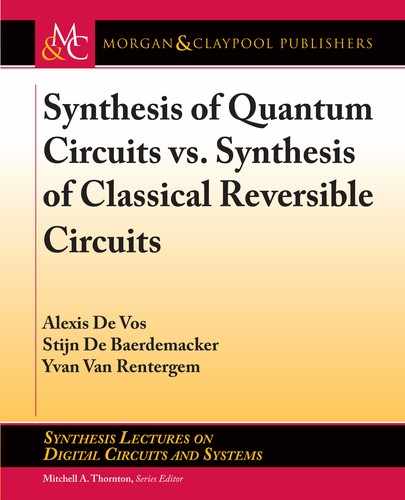
4.3. GROUP STRUCTURE 71
the remaining qubit:
U
H
H
D
D C B A
:
(4.5)
We now can apply the above decomposition to each of the four circuits A, B, C , and D.
By acting so again and again, we finally obtain a decomposition into
• h D 2.4
w1
1/=3 HADAMARD gates, and
• g D 4
w1
non-HADAMARD quantum gates acting on a single qubit.
As the former gates have no parameter and each of the latter gates has four parameters, the
circuit has 4g D 4
w
parameters, in accordance with the n
2
degrees of freedom of the given
matrix U . We note that all h C g single-qubit gates are controlled gates, with the exception of
two HADAMARD gates. For w D 3, the circuit looks like
:
It contains g Ch D
5
12
4
w
2
3
D 26 times the symbol .
One might continue the decomposition by decomposing each single-qubit circuit into
exclusively NEGATOR gates and PHASOR gates. Indeed, we can rewrite (3.6) as
1 0
0 ˇ
0 1
1 0
1 0
0 ˛
1
2
1 1 C
1 C 1
1 0
0 ı
;
in other words, a cascade of three PHASOR gates and two NEGATOR gates. One of the latter is
simply a NOT gate. In particular for the HADAMARD gate H, we have the decompositions (3.9) and
(3.10). We thus end up with a decomposition consisting of 2h C 2g NEGATORs and 3h C 3g
PHASORs. Among the 2h C 2g NEGATORs, h C g are NOTs and h are square roots of NOT.
4.3 GROUP STRUCTURE
We recall that the U(n) matrices with all line sums equal to 1 form the subgroup XU(n) of U(n).
For even n, the XU(n) matrices of the particular block type
1
2
I C C I C
I C I C C
; (4.6)
..................Content has been hidden....................
You can't read the all page of ebook, please click here login for view all page.
